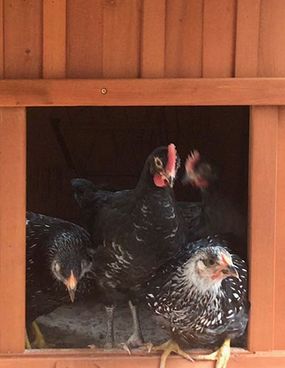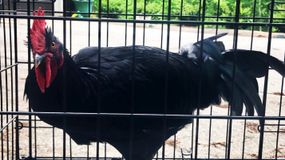A male chicken goes by several different names depending on its age. The most common terms for a male chicken are rooster, cockerel, and cock. Understanding the differences between these names can help you better communicate with other chicken owners and farmers.
Cockerel
A young male chicken under one year old is referred to as a cockerel Cockerels are typically between 6-8 weeks to one year in age You may also hear them called young roosters,
As cockerels mature you’ll notice their combs and wattles growing bigger and turning bright red. Their hackle, saddle, and sickle feathers will start to elongate and point as they approach one year old. Cockerels also tend to have thicker legs and larger feet than female chicks.
Rooster
Once a cockerel is over a year old, it becomes known as a rooster or cock. A rooster’s comb and wattles are usually larger and redder than a cockerel’s. Their legs are thicker, their spurs longer, and their hackle, saddle and sickle feathers are fully developed into long, distinctive plumage.
The most obvious sign of a rooster is their crowing. Roosters start crowing around 4-5 months old as they reach sexual maturity. However, some hens can crow too, so crowing alone doesn’t confirm gender.
Behavioral Differences
There are some key differences in behavior between cockerels and hens
-
Cockerels tend to be more aggressive, establishing pecking order and competing for status in the flock.
-
Cockerels stand taller, practice chest puffing, and have an upright stance.
-
Cockerels may fight with each other and challenge the older roosters.
-
Cockerels are usually the most personable chickens, readily approaching their caretakers.
-
Cockerels start “tidbitting” earlier – scratching and calling hens over to food they’ve found.
What About Capons?
A capon is a neutered or castrated male chicken. Caponization turns a cockerel into a capon before they reach sexual maturity and develop the physical characteristics of a rooster.
Capons are valued for their tender, flavorful meat. Since they don’t expend energy on breeding behaviors, capons convert feed to muscle growth efficiently.
Uses for Roosters
Mature roosters serve several important functions in a flock:
-
Act as watchdogs, alerting hens to danger with warning calls.
-
Keep hens from wandering by rounding them up.
-
Find and share food with hens through tidbitting.
-
Provide protection from aerial and ground predators.
-
Fertilize eggs for reproduction.
While each flock only needs 1-2 roosters, many chicken owners choose to keep roosters for their beauty, personality, and guarding abilities despite not needing fertilized eggs.
Terminology Summary
To summarize the key terminology:
- Cockerel: Male chicken under 1 year old
- Rooster/Cock: Adult male chicken over 1 year old
- Capon: Castrated male chicken
Understanding the differences between a cockerel, rooster, and capon can help chicken owners use the proper labels for their flock members. With their regal plumage and mannerisms, roosters are a sight to behold as they dutifully watch over their hens.
-p-1600.jpg)
Identifying an Adult Female vs. an Adult Male Chicken
When chicks mature, chicken breeders use a few visual signifiers to distinguish roosters from an adult hen.
The most obvious features between them are the rooster combs and wattles: flaps of skin that indicate high levels of testosterone and may also signal that the rooster is ready to fight off any male rivals. Most breeds of roosters feature a bright red comb for maximum visibility.
Other common indicators are the development of leg muscles and orientation of feathers. As they become ready to lay eggs, most adult female chicken breeds develop thicker legs with short, stubby claws. Meanwhile the same breed of roosters tend to retain long legs with sharp claws on their feet for defense.
Hen feathers tend to be soft and plush all along the body, while the rooster grows coarser, more exaggerated feathers. Hens keep short, rounded hackle feathers for their whole life, while most male chickens develop long and ornate hackle feathers along the ridge of their back.
Then there are the long saddle feathers, which populate the tail area and either point rearward or fan out to make the rooster appear larger to foes.
Can Female Chickens Change Sex?
Miss Lucille was a sweet little pullet (young hen), who found a cozy home in the chicken coop of Kristi Allens (not her real name) Powder Springs, Georgia, backyard. Initially, things appeared to be status quo with the young exchequer leghorn cross.
After observing her for a time, however, Allen noticed Miss Lucille was growing a comb. Although both sexes of the breed can have them, Allens instincts told her that perhaps something wasnt quite standard, so she sought the help of a local farmer. Allen recalls:
Advertisement “The farmer did all of the checks to confirm Miss Lucille was a miss. She had no long saddle feathers [pointy feathers at the base of the tail], no aggression, didnt jump or react in the presence of all the hens and roosters, and when she was laid back in the farmers hand, she stuck her legs out straight and just laid there. All are old timers tricks to identifying adult roosters since theres no definitive way to tell until they mount another chicken or crow, aside from lab testing.”
Miss Lucille had “failed” the rooster test. However, later on, Allen arrived home to a mess of feathers in the backyard, an unusual event because female chickens dont usually molt until around 18 months. She also started exhibiting more aggressive behavior.
“She began acting more temperamental, but I attributed that to her molting, as it can be quite uncomfortable for chickens,” she says. “I was worried about her health.”
Although strange things were certainly afoot in Miss Lucilles world, none of them were health-threatening. When her feathers grew back, they were pointed saddle feathers, signaling a transition to an adult male chicken. Her hackles and tail feathers had also undergone some major changes.
“She went from being your typical hen to a rooster with beautiful, long tail feathers and pointy hackles. Her gait changed, and she was definitely at the top of the pecking order,” Allen says.
Further consultation advised a wait-and-see approach. One farmer told her, “Just because she now looked like a rooster didnt mean she was one. I needed to wait until she crowed or mounted one of the hens.”
Ironically, Miss Lucille became more mellow and friendly. “But then her comb kept getting bigger and redder. For every indicator she might still be a she, there was another for her being a he,” she says.
Finally, the irrefutable proof came at around 5 months of age: The rooster literally crowed. “Every day the crow grew louder and stronger. It was official that Miss Lucille was now Mr. Lucille,” Allen says.
“And to his credit, he assumed the role wonderfully. If the girls were low on water, hed crow and let me know to get on it. Hed lead the charge up to roost at night. Hed wake us up with his song early each morning.”
Chicken | Rooster Crowing Sound #shorts
FAQ
What is a male chicken?
A male chicken is called a rooster.
What is the proper name for a male chicken?
Cock: a fertile adult male chicken. Cockerel: a young male chicken. Hen: an adult female chicken.
Can a male chicken not be a rooster?
Yes, a male chicken can be referred to by other names besides “rooster,” particularly when they are young or have been castrated. A young male chicken is called a cockerel, and a castrated male chicken is called a capon.
What is a male chicken called?
Male chickens are known as Roosters. In the United Kingdom and Ireland, adult male chickens over one year old are known as cocks whereas in the United States, Canada, Australia and New Zealand, they are more commonly called roosters. Also, the young male chickens are known as cockerel in the UK and Ireland. So, Rooster is a male fowl.
Is a chicken a female or a male?
Chickens are not a sex, they are a type of bird. If all chickens were females, there would be no more chickens since they couldn’t produce any more. To make it easier to describe them, we call female chickens hens or pullets and male chickens are called cocks, cockerels or roosters, but they are all chickens.
Do we eat male chickens?
Yes, we can eat male chickens just like hens. They almost have the same nutrition value and are safe to eat. It is not written anywhere that people should not eat roosters. You may never have heard of people consuming roosters. However, the fact is that several people enjoy this meat and even prefer it to hen meat.
What do you called a young male chicken?
A young male chicken is called a Cockerel. This is term typically given to a male chicken that is less than a year old. After a year, or when they mature and start mating they become roosters. The world of chickens can get a little confusing at times as they are lots of different terms, names, and terminology to learn.


